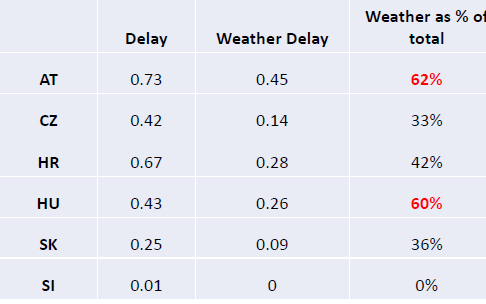Annual traffic growth rates for FAB CE States between 2018 and 2017 have reached record numbers, according to figures from the Eurocontrol Performance Review Unit, well above the upper forecasts of the agency’s Statistics and Forecast Service, STATFOR. STATFOR forecasts are used to determine target performance levels for European air navigation service providers (ANSPs) and functional airspace blocks (FABs).
In Croatia the growth rate has reached 11.3%, in Slovakia 11.2%, in Hungary 11%, in Slovenia 10.3% while the growth in the Czech Republic has reached 7.3% and Austria 6.2%.
“Some of these growth rates are more than double the upper traffic forecasts of STATFOR and are unprecedented,” said Matej Eljon, FAB CE Programme Manager and director of FAB CE Aviation Ltd. “It has required significant efforts to cope with this unpredictable traffic and not to cause disruption to the entire network.”
One consequence of the higher than forecast growth rate has been an increase in air traffic flow management (ATFM) delays as FAB CE controllers have struggled to accommodate unprecedented demand within the available airspace capacity. ATFM delays by the end of August among FAB CE states reached an average of 1.0 minutes per flight, compared to 0.22 minutes in 2017 during the same period. By the end of the year FAB CE delay at FIR level are forecast be around 0.81 minutes per flight, compared with the target of 0.28 minutes per flight.
But higher than forecast growth rates were not the only reason for the increase in ATFM delays.
FAB EC capacity constraints have had a significant impact in the FAB CE area following the introduction of mandatory re-routing and level capping scenarios to reduce the delay in Germany’s Karlsruhe Upper Area Control Centre (UAC), significantly increasing the workload of neighbouring partners Vienna Upper Area Control Centre (ACC), Warsaw ACC and Prague ACC.
“While the delay situation for Karlsruhe ACC has improved, these measures led to an increase in delays for Vienna and Prague ACC which has been reflected in the overall FAB CE performance,” said Matej Eljon. ”Network Manager analyses suggest that no major capacity improvements should be expected in Karlsruhe in the next year or two.”
A third factor has also played a major role in the worsening delay situation – increasingly volatile weather, which is now responsible for 51% of delays in FAB CE. In Austria, for example, weather delays have more than quadrupled over the past few years but other FAB CE States have also significant increases in weather related delays over the last year or so (see table below).

